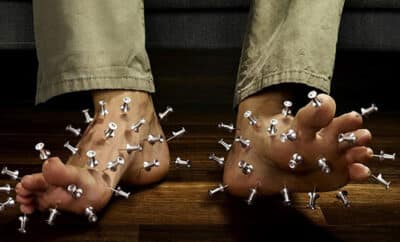Sleep: A Medical Necessity
 By Dr. Paul Imber, MD
By Dr. Paul Imber, MD
We spend a third of our lives sleeping, and the quality of our sleep determines aspects of our overall health. Sleep deprivation can be defined as a lack of quantity or quality of sleep. Sleep deprivation leads to personality changes, memory loss, increased accidents in the workplace and on the roadways, decreased productivity at work and school, hypertension, risk of cardiac disease and stroke, decreased success in rehabilitation after stroke, gastroesophageal reflux disease, right-sided heart failure – even sudden death!
One of the most common causes of sleep deprivation is obstructive sleep apnea (OSA). This occurs when the musculature of the upper airway collapses while sleeping. During sleep our muscle tone relaxes and the airway narrows, which can cause snoring. This can be a hallmark of OSA. During deep sleep, REM sleep, the musculature relaxes even more causing a collapse of the opening and loss of inspiratory airflow. The brain perceives the lack of oxygen and awakens to a lighter stage of sleep, thus decreasing the quality of sleep. These events cycle through the night, and can occur as frequently as 100 times per hour in some patients. The oxygen level can drop dangerously low during these episodes, which can cause morning headaches upon awakening in these patients. Common symptoms for OSA patients can include loud snoring with gap episodes (stop breathing) of 10-15 seconds or more, awakening poorly rested sometimes with headache, daytime lethargy with napping if sedentary, difficulty driving distances, increased irritability, learning problems and hyperactivity in children, awakening through the night, and dry mouth when awakening due to mouth breathing. Many times the patient does not realize that he/she has the problem, and it only is noted when bed partners raise the issue of their own disrupted sleep by the snoring mate.
OSA occurs in up to 6% of the population, usually between ages 50 to 60, although it can occur at all ages. In the pediatric population it is most commonly related to tonsil and adenoid enlargement. In adults, OSA can be caused by anatomic obstruction in the nose and throat which can include allergy, septal deviation, tonsil and adenoid enlargement, fullness and elongation of the soft palate and uvula, decreased muscle tone from female and male menopause, airway obstruction of the base of the tongue and around the voice box.
If you think you or your partner may have sleep apnea, evaluation by a specialist is recommended. It is important that the patient with OSA be fully evaluated and examined for causes of the problem, as some of these causes can be corrected or modified through medical and/or surgical treatment. The diagnosis is confirmed with a sleep study, which frequently can be performed at home over a few nights. The home sleep test involves a few sensors to monitor airflow, chest and body movement, and oxygen level of the blood. The test is painless and much more comfortable than in a lab study.
If OSA is diagnosed, it will be rated as mild, moderate or severe depending on the frequency of apneic episodes and the drop in oxygen in the blood. It may show that the episodes only occur when the patient is on their back, which can be treated with positional modification. It may be recommended that a PAP study be performed, to see if positive airway pressure will correct the blockage (think of a gentle stream of air blowing through a balloon just enough to keep it opened but not inflated). On occasion an oral appliance may be recommended to adjust the position of the jaw during sleep, thus opening the back of the throat. Surgical procedures can also be performed to open the nasal passage, reshape the back of the throat, remove tonsils and decrease some of the tongue base. Also, control of allergy congestion and symptoms can enhance the effectiveness of these treatments. Sometimes, success is best achieved with a combination of these options. There is even a new device to stimulate the nerve in the neck to contract the opening muscles of the throat which is attached to a pacemaker that paces the contractions to your inspiration while asleep.
Obstructive sleep apnea does not have to interrupt the sleep of multiple people if treated aggressively. There are different treatments that can help you and your sleeping partner, giving you both an improved quality of life and health.
Paul Imber, DO is a practicing, board certified Otolaryngologist in private practice in Delaware since 1982. He is one of the physicians at ENT & Allergy of Delaware, which has four locations throughout New Castle County.
For further information regarding ENT and Allergy of Delaware please go to www.entad.org





